When you’re writing content for your website, constantly repeating the same keywords just to hit some arbitrary percentage doesn’t convince anyone. It’s the clear, helpful explanations that truly draw people in and keep them reading.
Instead of obsessing over old-school “rules” like aiming for 1% keyword density, which can make your page sound robotic and off-putting to real readers, focus on creating natural, flowing text that solves problems.
Your audience is someone searching online with a specific issue in mind, your content is the straightforward answer they need, and your webpage is the tool that delivers that solution without any unnecessary padding or confusion.
For beginners new to SEO, the good news is that when you prioritize writing in a way that genuinely covers the topic using everyday language, the search engines will naturally recognize your page’s relevance, leading to better rankings without you having to force anything.
Table of Contents
What Actually Matters for Keyword Density
What truly drives your page’s success in search results isn’t a magic number of keyword repetitions. It’s how well your content meets the needs of the person searching, providing real value from the very first sentence to the last.
Shift your attention to fully addressing the search intent, which means understanding what questions or problems brought the reader to your page and answering them completely. Include related subtopics that naturally come up in similar searches, add a FAQ section for common follow-ups, and back everything up with simple examples or evidence that make your points relatable.
This approach encourages the use of varied language, like synonyms or related ideas, which shows depth and expertise without coming across as repetitive or forced, perfect for beginners who want their writing to feel authentic and engaging.
- Search intent satisfied end to end – Cover the full journey from problem to solution.
- Clear topical coverage with subtopics, FAQs, and examples – Build a comprehensive yet easy-to-follow structure.
- Entities and synonyms used naturally where they fit – Weave in related terms smoothly for better context.
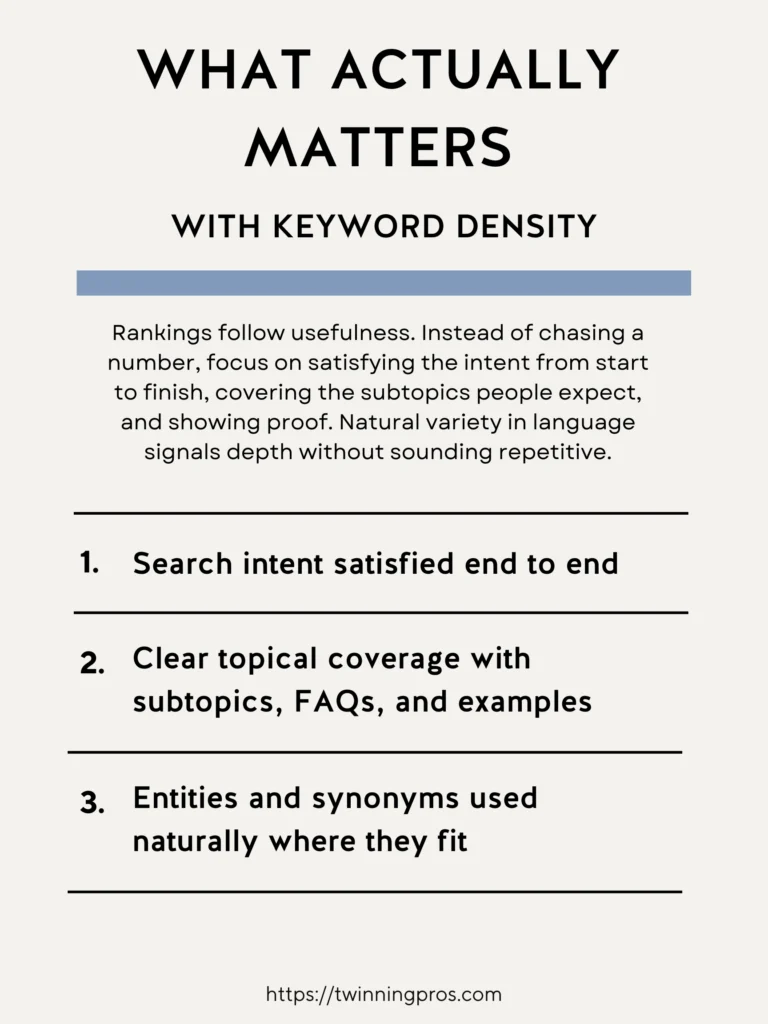
Smart Placement Beats Repetition when it comes to Keyword Density
Rather than scattering your main keyword everywhere just to boost a count, place it thoughtfully in spots where readers naturally look for confirmation that they’re on the right page. This keeps things human-readable while giving search engines clear signals about your topic.
Start strong by including your primary keyword in the title tag (the headline in search results), the H1 (your page’s main heading), the opening paragraph to set the stage, one or two subheadings (H2s) for emphasis, and wrap up with it in the conclusion to reinforce the message.
Throughout the rest of the body, let variations and related phrases flow where they make sense, avoiding any awkward shoehorning. Even your internal links’ anchor text should be descriptive and helpful, like “check out our guide to title tags,” rather than over-optimized repeats. This way, beginners can create content that feels natural and guides visitors effortlessly.
- Primary term in the title tag, H1, intro, 1–2 H2s, and conclusion – Key spots for visibility.
- Variations used throughout the body only where relevant – Keeps it organic.
- Anchor text that is descriptive, not over-optimized – Helps navigation without spamming.
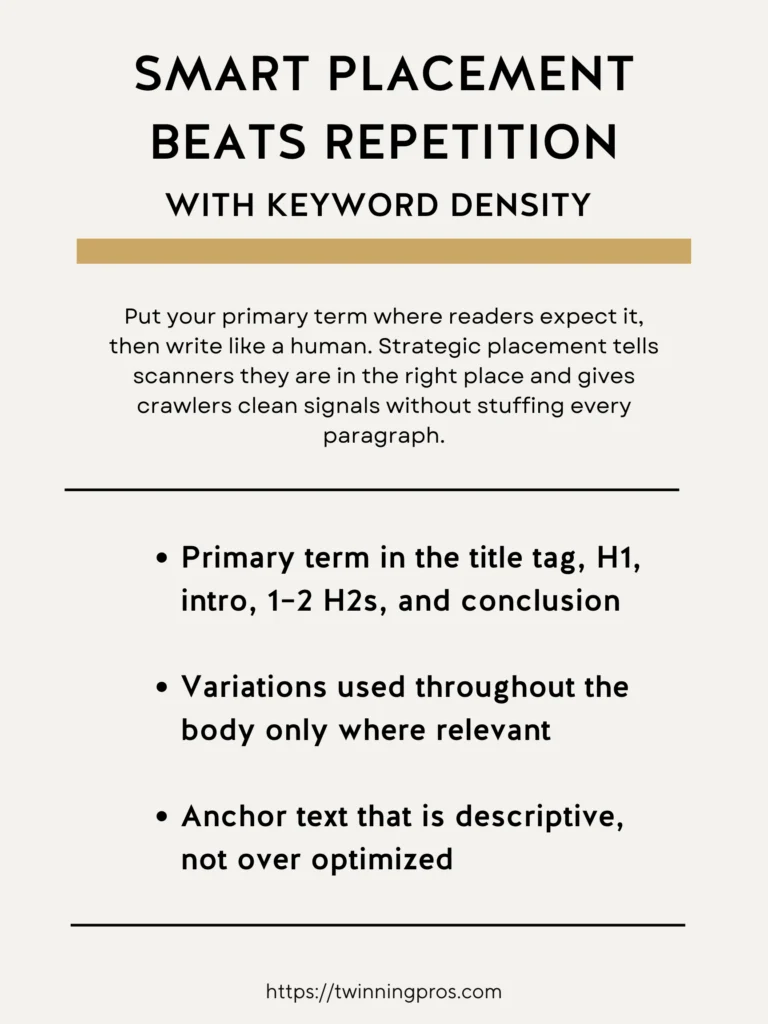
Use Synonyms and Related Entities for keyword density
In everyday conversation, no one says the exact same word over and over. It sounds unnatural and can make your content hard to read. Instead, mix in synonyms (different words with similar meanings) and related entities, like specific brand names, tools, places, results, or steps that tie into your topic.
For SEO beginners, this means thinking about how your audience actually talks or searches: if your main keyword is “window cleaning,” naturally include phrases like “spotless glass polishing” or mention tools such as “squeegee techniques” where they fit the discussion.
These additions not only make your writing more engaging and varied but also help search engines see the broader context of your page, connecting it to related searches and improving its overall relevance without any forced repetition.
- Replace repeats with natural phrases your audience uses – Mirrors real speech.
- Add supporting terms such as tools, locations, steps, and outcomes – Enriches without stuffing.
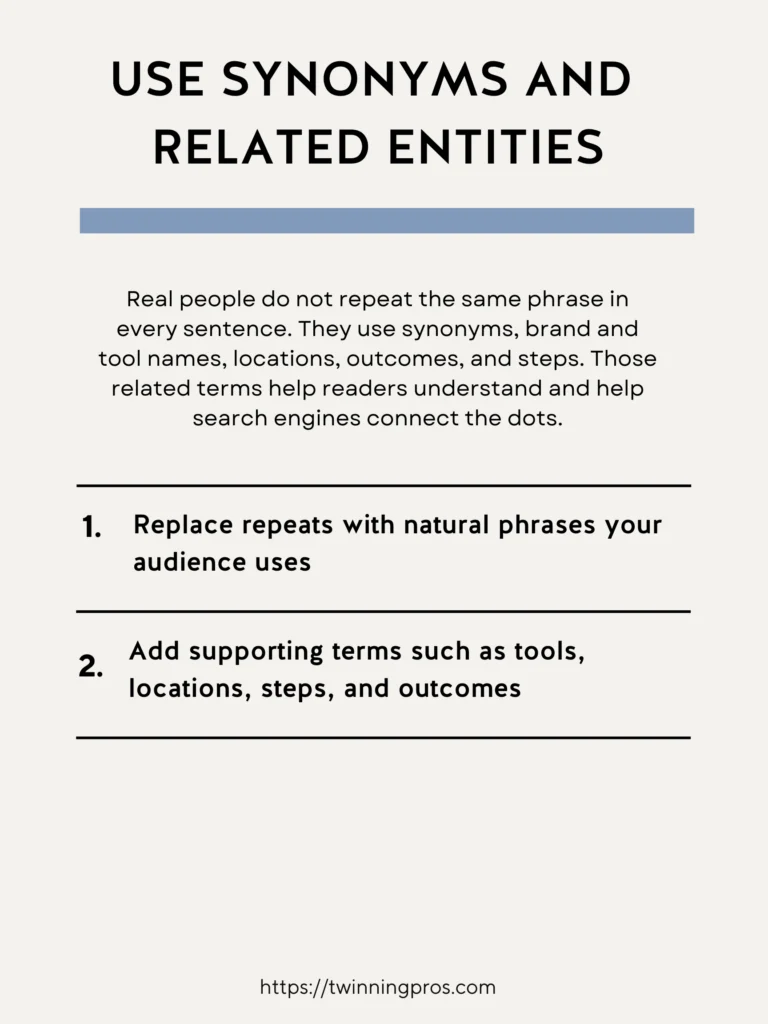
Read Aloud and Skim Tests
A couple of simple tests can reveal if your content flows well or if it’s bogged down by unnatural keyword use. Start by reading your page out loud, as if sharing it with a friend; if any part sounds clunky or overly repetitive, it’s a sign to revise for smoother language. Your ear will catch what your eyes might miss, ensuring the text feels conversational and trustworthy.
Next, try skimming just the headings, bullet points, captions under images, and link texts. If you can still understand the main argument and value, your structure is solid and scanner-friendly.
For beginners, these quick checks are invaluable, helping you craft pages where each paragraph focuses on one clear idea in simple, active language, making the whole piece more readable and effective without needing fancy tools.
- If it sounds stuffed, it is – Trust your reading aloud.
- Each paragraph should teach one idea in plain language – Keeps focus sharp.
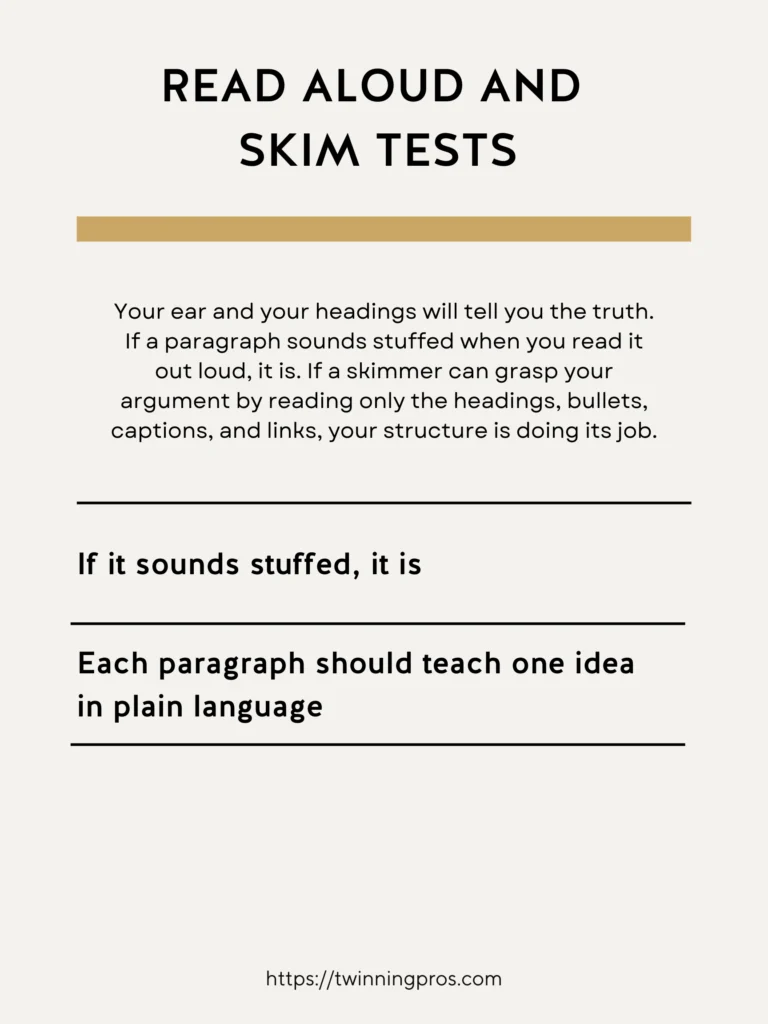
Quick Relevance Checklist
Before you publish, spend a minute or two on this easy checklist. It’s designed for SEO beginners to ensure your page emphasizes clarity and thorough coverage, so you can ditch keyword density calculators for good.
Confirm your main keyword shows up in the essential places like the title, heading, and intro without overdoing it; verify that your sections align with what top search results cover, plus any unique insights from your experience; check that synonyms and related terms appear naturally; and scan for any awkward repetitions aimed at hitting a quota. This straightforward review helps you create content that’s helpful first and optimized second, leading to better engagement from real readers.
- Primary term appears where it counts (title, H1, intro) – Strategic without excess.
- Section coverage matches top results plus your unique expertise – Comprehensive and original.
- Synonyms and entities sprinkled naturally – Adds variety.
- No awkward repeats to “hit” a percentage – Prioritizes flow.
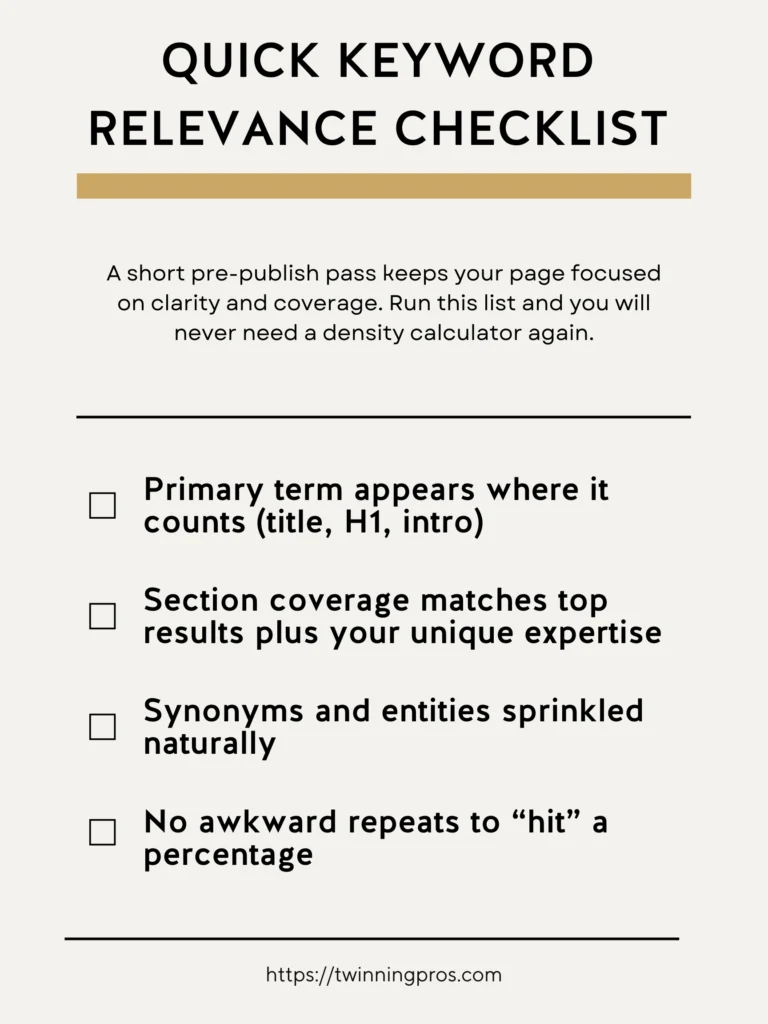
Final Thoughts
Forget density. Aim for clarity. Use the primary term in the title, H1, early in the first paragraph, and in one subhead if it fits naturally. Sprinkle close variants where they help readers find what they expect. Let natural language and complete coverage do the rest.
Routine. Map one primary topic per page. Draft for humans first. Review once to confirm coverage of key terms that match the reader’s questions. Remove repeats that add nothing. Publish, then improve based on engagement, not on counts.
Next Steps
As you’ve seen throughout this beginner’s guide to SEO fundamentals, small, consistent tweaks can make a massive difference in how search engines and visitors perceive your site. But remember, true success comes from a holistic approach tailored to your unique business. If you’re ready to take your SEO to the next level, check out our professional SEO services, where we handle everything from keyword research to on-page optimization to help you rank higher and attract more customers.
No matter where you are on your SEO journey, whether you’re just starting or already seeing some traction, it’s essential to have your website professionally audited at least twice a year to uncover hidden issues and keep things running smoothly; our comprehensive SEO Audit dives deep into your site’s performance, providing actionable insights without the overwhelm.
And if you want to build these skills yourself, enroll in our beginner-friendly course, The SEO CEO, I’m Tabatha, an SEO expert with years of hands-on experience, and after reviewing countless beginner courses that gloss over the details and lack real-world examples, I designed this in-depth program with plain-English lessons, step-by-step templates, and live walkthroughs so you can start applying these fixes today, not after wading through vague theory. Let’s turn your website into a traffic magnet; get started now and watch your online presence grow.
Keyword Density FAQs
Is there a recommended keyword density for SEO?
No. Google does not have an optimal percentage. Be explicit about the topic in natural language so users and Google understand the page.
Should I repeat the keyword several times just to rank?
No. Repeating words unnaturally is keyword stuffing and violates Google’s spam policies. It also makes content hard to read.
Where should I use my primary keyword?
Place it naturally in the title tag, the main heading, early in the introduction, one or two subheadings if relevant, and near the conclusion. Focus on clarity and intent rather than repetition. This aligns with Google’s people-first guidance.
Do synonyms and related terms help?
Yes. Use the words your audience uses to describe the topic, including natural variations and related entities. You do not need to list every variant.
What are signs I might be overdoing keywords?
If a paragraph reads awkwardly, lists towns or keywords out of context, or repeats the same phrase just to include it, you are likely crossing into stuffing. Edit for natural, helpful wording.
What should I do instead of chasing a percentage?
Write people-first content that fully answers the searcher’s task, shows first-hand experience, and organizes information clearly. That is what Google’s systems aim to reward.
What is a quick keyword density pre-publish checklist?
– Read the page out loud and delete any repeated phrases that do not add meaning. – Ensure the primary term appears where it helps comprehension, not as padding.
SEO for Beginners
Learn from the SEO Strategist who has 75+ first page Google rankings under her belt.
We’re marketing nerds and business strategists that have generated millions of dollars in client revenue. We're sharing the systems and strategies to help your growing business with marketing that actually converts.
We're Tiffany + Tabatha

Comments